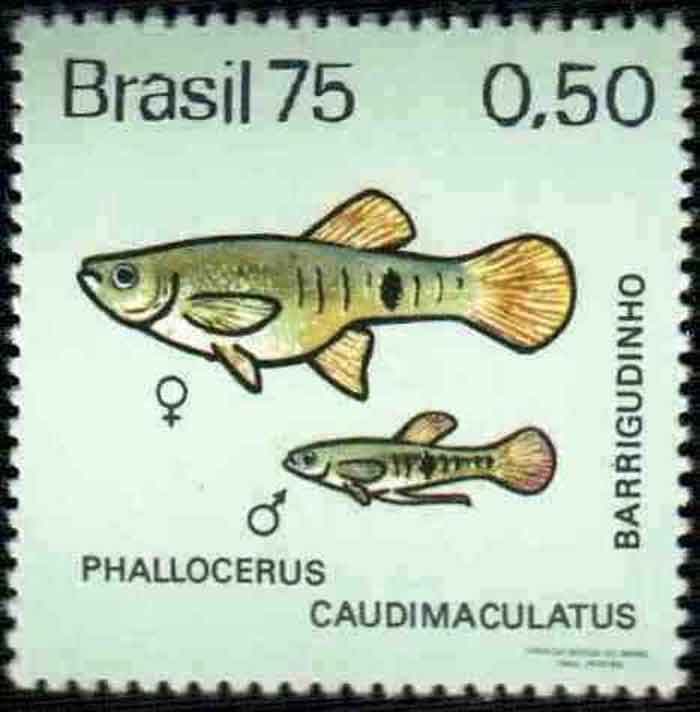Superregnum: Eukaryota
Cladus: Unikonta
Cladus: Opisthokonta
Cladus: Holozoa
Regnum: Animalia
Subregnum: Eumetazoa
Cladus: Bilateria
Cladus: Nephrozoa
Superphylum: Deuterostomia
Phylum: Chordata
Subphylum: Vertebrata
Infraphylum: Gnathostomata
Megaclassis: Osteichthyes
Superclassis/Classis: Actinopterygii
Classis/Subclassis: Actinopteri
Subclassis/Infraclassis: Neopterygii
Infraclassis: Teleostei
Megacohors: Osteoglossocephalai
Supercohors: Clupeocephala
Cohors: Euteleosteomorpha
Subcohors: Neoteleostei
Infracohors: Eurypterygia
Sectio: Ctenosquamata
Subsectio: Acanthomorphata
Divisio/Superordo: Acanthopterygii
Subdivisio: Percomorphaceae
Series: Ovalentaria
Superordo: Atherinomorphae
Ordo: Cyprinodontiformes
Subordo: Cyprinodontoidei
Familia: Poeciliidae
Subfamilia: Poeciliinae
Tribus: Cnesterodontini
Genus: Phalloceros
Species: P. alessandrae – P. anisophallos – P. aspilos – P. buckupi – P. caudimaculatus – P. elachistos – P. enneaktinos – P. harpagos – P. heptaktinos – P. leptokeras – P. leticiae – P. lucenorum – P. malabarbai – P. megapolos – P. mikrommatos – P. ocellatus – P. pellos – P. reisi – P. spiloura – P. titthos – P. tupinamba – P. uai
Name
Phalloceros Eigenmann, 1907
Gender: masculine
Type species: Girardinus caudimaculatus Hensel, 1868, by original designation and monotypy.
References
Eigenmann, C. H. 1907, The poeciliid fishes of Rio Grande do Sul and the La Plata Basin. Proceedings of the United States National Museum 32 (1532): 425–433.
Paulo Henrique Franco Lucinda, 2008, Systematics and biogeography of the genus Phalloceros Eigenmann, 1907 (Cyprinodontiformes: Poeciliidae: Poeciliinae), with the description of twenty-one new species. Neotropical Ichthyology 6(2): 113–158 [1]

Phallocerus caudimaculatus
Phalloceros is a genus of poeciliids native to freshwater habitats in Brazil, Paraguay, Uruguay and northern Argentina. The majority are endemic to southern and southeastern Brazil (only exceptions are P. caudimaculatus, P. harpagos and P. leticiae).[2] P. caudimaculatus has long been part of the aquarium industry and has been introduced to countries far from its native range.
Species
There are currently 22 recognized species in this genus:[3]
Phalloceros alessandrae Lucinda, 2008
Phalloceros anisophallos Lucinda, 2008
Phalloceros aspilos Lucinda, 2008
Phalloceros buckupi Lucinda, 2008
Phalloceros caudimaculatus (R. F. Hensel, 1868) (Dusky millions fish)
Phalloceros elachistos Lucinda, 2008
Phalloceros enneaktinos Lucinda, 2008
Phalloceros harpagos Lucinda, 2008
Phalloceros heptaktinos Lucinda, 2008
Phalloceros leptokeras Lucinda, 2008
Phalloceros leticiae Lucinda, 2008
Phalloceros lucenorum Lucinda, 2008
Phalloceros malabarbai Lucinda, 2008
Phalloceros megapolos Lucinda, 2008
Phalloceros mikrommatos Lucinda, 2008
Phalloceros ocellatus Lucinda, 2008
Phalloceros pellos Lucinda, 2008
Phalloceros reisi Lucinda, 2008
Phalloceros spiloura Lucinda, 2008
Phalloceros titthos Lucinda, 2008
Phalloceros tupinamba Lucinda, 2008
Phalloceros uai Lucinda, 2008
References
Eschmeyer, William N.; Fricke, Ron & van der Laan, Richard (eds.). "Phalloceros". Catalog of Fishes. California Academy of Sciences. Retrieved 10 November 2019.
Paulo Henrique Franco Lucinda; Roberto E. Reis (2005). "Systematics of the subfamily Poeciliinae Bonaparte (Cyprinodontiformes: Poeciliidae), with an emphasis on the tribe Cnesterodontini Hubbs". Neotropical Ichthyology. 3 (1): 1–60. doi:10.1590/S1679-62252005000100001.
Froese, Rainer and Pauly, Daniel, eds. (2012). Species of Phalloceros in FishBase. August 2012 version
Retrieved from "http://en.wikipedia.org/"
All text is available under the terms of the GNU Free Documentation License

